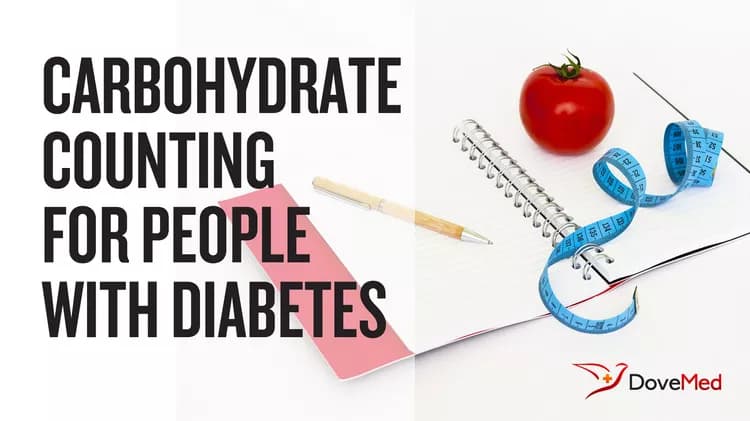Carbohydrate counting or “carb counting” is a meal planning method used for the management of blood glucose levels. The technique is used oftentimes by those suffering from diabetes, as these individuals need to find a balance between how much insulin is in their body and their carbohydrate intake. By counting the carbohydrates that are consumed for each meal and setting a maximum limit, as well as balancing medicine and physical activity, diabetes patients are able to keep blood glucose levels in their target range.
Carbohydrates in food are the main nutrients that have an impact on blood sugar. Within 1-2 hours post carbohydrate consumption, most of it is converted to blood sugar, emphasizing its impact in the management of diabetes.
Carbohydrate counting offers more variety in choices and provides more accurate assumptions of how much blood sugar will rise after a meal or snack. A number of carbohydrates one can consume is based on the individual, as this value significantly varies among diabetics. The right amount of carbohydrates depends on the medicines they take and their physical activity level. Finding this balance is crucial for feeling your best and lessening your risk of diabetic complications.
The American Diabetes Association recommends starting with 45-60 grams of carbohydrates per meal. This number will vary depending on the individual and the course of action you take to manage your diabetes. Your healthcare expert can help you determine the appropriate number for you.
Common carbohydrate containing foods include:
- Grains such as rice, barley, and oatmeal
- Grain based food like bread, pasta, cereal, or crackers
- Starchy vegetables such as potatoes, peas, and corn
- Milk and yogurt
- Fruit and juice
- Dried beans and soy products
- Snack foods and sweets like sodas, cake, cookies, candy, and chips
Examining food labels is an efficient way to determine a number of carbohydrates in foods. Foods without nutrition labels need to be estimated using online references or tables. In order to better understand and relate to how many carbohydrates certain foods contain, the American Diabetes Association has outlined a few choices that all contain approximately 15 grams of carbohydrates:
- 1 small piece of fruit (4 oz)
- 1 slice of bread of 6” tortilla
- 1/3 cup pasta or rice
- 2 small cookies
- 1 cup of soup
- ¼ of a large baked potato (3 oz)
- 6 chicken nuggets
- ½ cup oatmeal
In the absence of food labels, it is important to factor in the serving size and total carbohydrate content. Food labels contain all of the foods information for that particular serving size. If eating a larger portion than the label suggests, these numbers need to be doubled or tripled to properly estimate the carbohydrate content. In the nutritional value chart on each food label, look for grams of total carbohydrates, as this includes the sugar, starch, and fiber content altogether. If you are attempting to lose excess weight, also factor in the caloric value. Comparing foods and choosing the one with fewer calories can be helpful to shed those extra pounds. With carbohydrate counting only focusing on carbohydrates themselves, it is easy to downplay the protein and fat content in each food. It is essential to include a source of protein and healthy fat in each meal to balance it out.
Self-management of diabetes has been made easier and more controlled with carbohydrate counting. It encourages diabetics to be more involved in their maintenance and helps them to gain an awareness of how individual foods can impact blood sugar levels. Carb counting can even be useful for those attempting to lower their risk of developing diabetes in the future, as normal individuals can also experience the benefit from a controlled carbohydrate diet.
References:
Carbohydrate Counting [Internet]. American Diabetes Association; 2013 Oct 2 [updated 2014 Sep 15; cited 2015 Jan 26]. Available from: http://www.diabetes.org/food-and-fitness/food/what-can-i-eat/understanding-carbohydrates/carbohydrate-counting.html
Understanding Carbohydrates [Internet]. American Diabetes Association [cited 2015 Jan 26]. Available from: http://www.diabetes.org/food-and-fitness/food/what-can-i-eat/understanding-carbohydrates/
Carbohydrate Counting [Internet]. Children With Diabetes; 1998 Nov 25 [updated 2005 Aug 14; cited 2015 Jan 26]. Available from: http://www.childrenwithdiabetes.com/d_08_d00.htm
Helpful Peer-Reviewed Medical Articles:
Kulkarni, K. D. (2005). Carbohydrate counting: a practical meal-planning option for people with diabetes. Clinical Diabetes, 23(3), 120-122.
Franklin, V. L., Waller, A., Pagliari, C., & Greene, S. A. (2006). A randomized controlled trial of Sweet Talk, a text‐messaging system to support young people with diabetes. Diabetic Medicine, 23(12), 1332-1338.
Kawamura, T. (2007). The importance of carbohydrate counting in the treatment of children with diabetes. Pediatric diabetes, 8(s6), 57-62.
Bolderman, K. M. (2003). Practical carbohydrate counting: a how-to-teach guide for health professionals. American Diabetes Association.
Johnson, M. A. (2000). Carbohydrate counting for people with type 2 diabetes. Diabetes Spectrum, 13(3), 156.
Smart, C. E., Ross, K., Edge, J. A., Collins, C. E., Colyvas, K., & King, B. R. (2009). Children and adolescents on intensive insulin therapy maintain postprandial glycaemic control without precise carbohydrate counting. Diabetic Medicine, 26(3), 279-285.
Evert, A. B., Boucher, J. L., Cypress, M., Dunbar, S. A., Franz, M. J., Mayer-Davis, E. J., ... & Yancy, W. S. (2014). Nutrition therapy recommendations for the management of adults with diabetes. Diabetes care, 37(Supplement 1), S120-S143.
Related Articles
Test Your Knowledge
Asked by users
Related Centers
Related Specialties
Related Physicians
Related Procedures
Related Resources
Join DoveHubs
and connect with fellow professionals


0 Comments
Please log in to post a comment.